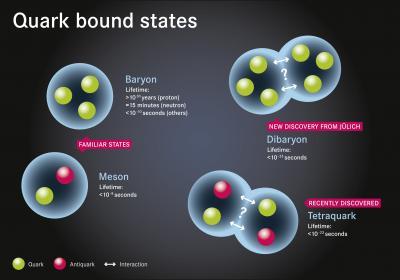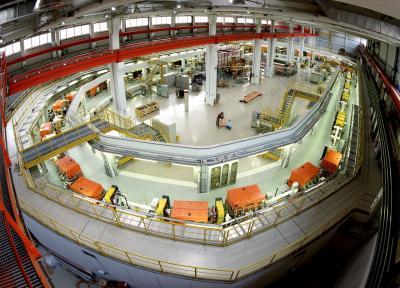For decades, physicists have searched for exotic bound states comprising more than three quarks.
In 2011, over 120 scientists from eight countries discovered strong indications for the existence of an exotic dibaryon made up of six quarks. Now, experiments performed at Jülich's accelerator COSY have shown that uch complex particles do exist in nature. This discovery by the WASA-at-COSY collaboration goes beyond what had been done before. Physicists were only able to reliably verify two different classes of hadrons: volatile mesons comprising one quark and one antiquark and baryons consisting of three quarks.
Protons and neutrons, which make up atomic nuclei, are examples of the latter. In recent years, however, there has been growing evidence for the existence of additional types of hadrons, for example, hybrids, glueballs, and multiquarks. In 1964, the physicist Freeman Dyson was the first to predict such more complex states but reliable verification was difficult because almost no measurements could be reproduced.

For a long time, physicists were only able to reliably verify two different classes of hadrons: baryons and mesons. Experiments performed at Jülich's accelerator COSY have now shown that, in fact, another class of exotic particles made up of six quarks exists. Source: Forschungszentrum Jülich/SeitenPlan (CC BY 4.0)
Only recently, other research groups – independently of each other – found strong indications for short-lived, exotic particles comprising four quarks, so called "tetraquarks". The new bound state, which has now been verified at COSY, means that yet another class of exotic particles has been identified.
"The new resonance that we observed confirms that quarks really do exist in six-packs. This discovery could open the door to new physical phenomena," says group spokesman Prof. Heinz Clement from the University of Tübingen.
The structure that was first discovered in 2011 is extremely short-lived and could only be detected via its decay products. The transient intermediate state – technical term: resonance – exists for a mere hundred-sextillionth (10 to the power of -23) of a second before it decays. This time span is so short that, for example, light can travel just a distance equivalent to the diameter of a small atomic nucleus.

The Jülich accelerator COSY (cooler synchrotron) with a circumference of around 180 meters provides high-precision beams of spin-polarized protons and deuterons for experiments. Source: Forschungszentrum Jülich
Whether all six quarks form a single compact entity or rather a "hadronic molecule" has yet to be clarified. The latter would be composed of several nuclear building blocks – for example of excited protons and neutrons bound to each other – yet much more strongly than inside an atomic nucleus.
"The measurements that we performed at COSY in 2011 were already very precise. But because the experiments could not be repeated at any other accelerator worldwide, we had to come up with another experiment to verify the results," explains Prof. Hans Ströher, director at the Nuclear Physics Institute (IKP-2) in Jülich.
In order to gain further unequivocal evidence of the exotic resonance named d*(2380), the scientists scanned the relevant energy range in an elastic scattering experiment. They bombarded a proton target with polarized, heavy hydrogen nuclei known as deuterons. The exotic bound state formed during the collision influenced the angle with which the particles moved away from each other after the collision, thus allowing it to be identified .
"The findings are part of a bigger picture. If this particle exists, then theoretically a whole range of other exotic states can be expected," says director at Jülich's IKP-1 Prof. James Ritman. The nuclear physicist is in charge of Jülich's contribution to the PANDA detector at the international accelerator complex FAIR in Darmstadt, where such exotic structures will be explored in more detail.
Source: Forschungszentrum Juelich




Comments